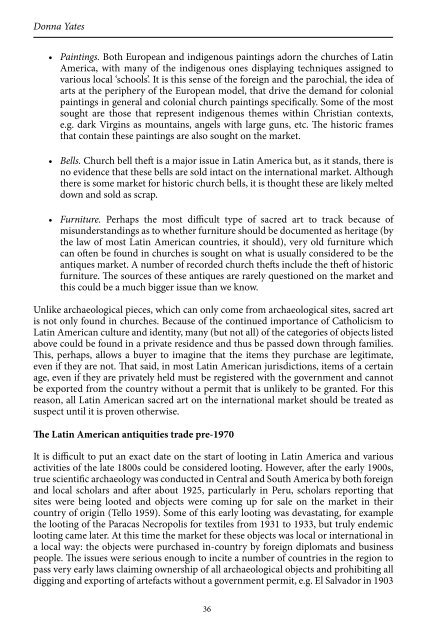Countering
Book_observatory_illicit_traffic_version%20issuu
Book_observatory_illicit_traffic_version%20issuu
You also want an ePaper? Increase the reach of your titles
YUMPU automatically turns print PDFs into web optimized ePapers that Google loves.
Illicit Trafficking in Latin America<br />
(Decree no. 4347), Bolivia in 1906 (Law of 3 October 1906), Peru in 1929 (Law no. 6634),<br />
Guatemala in 1947 (Decrete no. 425 of 1947).<br />
The scale of artefact looting and trafficking greatly increased when the market for<br />
Latin American antiquities became truly international. As points of sale to collectors<br />
shifted from the streets of Lima or Mexico City to New York, Paris, or Hollywood,<br />
and as demand increased, trafficking networks (both simple and complex) grew to fill<br />
the important middle transit stage of the antiquities smuggling chain and the pillage<br />
of archaeological sites rose sharply. Because most Latin American counties outlawed<br />
the export of antiquities before an international market grew for them, all the Latin<br />
American antiquities on the market were tainted by crime and were illegal in some<br />
jurisdictions. This is still the case.<br />
That said, there was no desire on the part of dealers and buyers (including major<br />
museums) to respect the law of the countries of origin at that time. It is often said that<br />
Latin American source countries have been treated with disrespect and indignity by<br />
the international antiquities trade. At this time pre-Conquest objects were the primary<br />
focus of looting and trafficking. Churches were robbed and early collections of colonial<br />
sacred art began to grow but the scale was not at the level seen today. Furthermore, many<br />
of the countries in question had not fully clarified their ownership of, and export bans<br />
on, sacred art at this time. Of course, sacred art that was outright stolen from a church<br />
was still stolen property, but at least from recorded sources, sacred art trafficking would<br />
largely come later.<br />
Although there are a number of ways Latin American antiquities left their country of<br />
origin at this time, a simplified model might include the following elements: a notable<br />
site would be located by locals, either people living in a nearby village or those who move<br />
through the jungle or desert as part of their subsistence activities. Because they know<br />
that there is a market for ancient items, locals would either sell this information to a<br />
local looting group or notify an intermediary who would finance illicit digging. Locals<br />
with previous experience might loot the site themselves. The items would quickly pass<br />
out of the hands of the locals and into those of an in-country intermediary, often but<br />
not always an expatriate, who worked with a particular out-of-country intermediary to<br />
smuggle the antiquities. The in-country intermediary would arrange the transit stage<br />
of the antiquities, perhaps with the help of local corruption, perhaps because of their<br />
own access to shipping methods. These intermediaries would either be paid upfront or<br />
given a cut of the future sale. The out-of-country intermediary would then receive the<br />
antiquities in the country of sale and ‘clean’ them both figuratively and literally for sale<br />
on the ‘legitimate market’, serving as a Janus figure connecting the criminal underworld<br />
and the respectable market (Mackenzie and Davis 2014).<br />
These intermediaries might be dealers themselves who would then sell the object on<br />
to a museum or collector, particularly a collector that they had a working relationship<br />
sourcing particular objects for. They also might be dealers to dealers, supplying objects<br />
to the established store-front and catalogue style dealerships. Oftentimes, it was these<br />
out-of-country intermediaries would supply a plausible back story and false paperwork<br />
to legitimize the smuggled objects. Finally, the object would be sold to a ‘legitimate’<br />
collector or museum who was fully aware of the illicit nature of the market they<br />
engaged in but would specifically choose to neither ask too many questions nor notify<br />
the authorities of suspect behaviour. There was almost no risk of punishment for any<br />
individual beyond the stage of in-country intermediary.<br />
37


